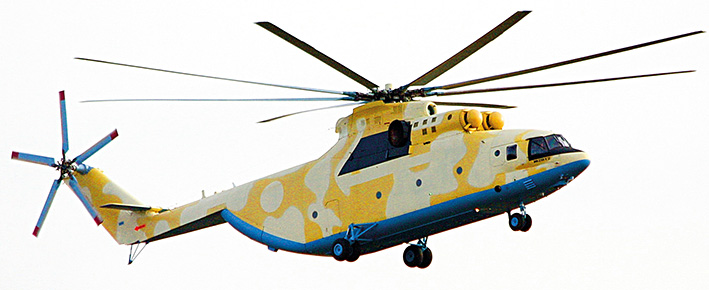|
 The first production-standard upgraded Mi-26T2 heavylift helicopter began its test programme at Rostvertol JSC, a subsidiary of the Russian Helicopters holding company, in Rostov-on-Don late in December 2014. The machine has a peculiar 'desert' camouflage pattern, which implies that the helicopter is intended for export. The first production-standard upgraded Mi-26T2 heavylift helicopter began its test programme at Rostvertol JSC, a subsidiary of the Russian Helicopters holding company, in Rostov-on-Don late in December 2014. The machine has a peculiar 'desert' camouflage pattern, which implies that the helicopter is intended for export.
According to Rostvertol's annual report published last summer, the first export contract for six Mi-26T2s for Algeria was made on 26 June 2013. Before that, in July 2012, a Mi-26T2 prototype (serial 901), which had been undergoing tests since early 2011, visited the country with a demonstration flight programme.
The key difference setting the Mi-26T2 from the production-standard Mi-26 and Mi-26T/TC is its advanced digital avionics suite that has allowed slashing the flying crew from four to two (from five to three, if the external cargo sling is used) and simultaneously improved reliability, flight safety, helicopter's stability, controllability and hover precision, which is especially important when using the external sling.
The BREO-26 avionics suite of the upgraded Mi-26T2 is based on the NPK-90-2 flight navigation system comprising the digital display system, control panels, airborne computer, satellite navigation system and digital flight system. In addition, the Mi-26T2's avionics incorporates an up-to-date communications system and an airborne flight recorder system.
Just like its baseline model, the Mi-26T2 can haul outsize cargo and vehicles weighing a total of 20 t in the cargo hold or at the external sling. Its military version carries 82 troops and casevac variant airlifts 60 casualties. The machine can perform installation and construction work of varying degrees of complexity, fire-fighting missions, quick fuel delivery, self-contained refuelling of vehicles on the ground, etc.
(Photo: aviaforum.ru)
|
